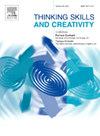Cognitive foundations in the interplay between computational thinking and creativity: A scoping review
IF 3.7
2区 教育学
Q1 Social Sciences
引用次数: 0
Abstract
Previous studies have explored the relationship between computational thinking (CT) and creativity. However, a consensus has yet to be reached since both CT and creativity varied in ideation and assessment. To uncover the cognitive mechanism underlying the interplay between CT and creativity, we conduct a scoping review of 26 empirical studies published in 2006–2024. Our findings suggested that the effects of working memory varied in the interplay between CT and creativity due to differences in age range, neural network activation regions, and measurements. Intellectual abilities, including algorithmic fluency, reasoning ability, and coding ability, showed cognitive transfer effect on CT skills but not necessarily on creativity, suggesting that cognitive abilities embracing more intelligent elements may contribute to the functional connectivity in CT neural networks but only partly overlapped with creativity involved networks. Although executive functions (working memory, cognitive flexibility, and inhibitory control) play a crucial role in both CT and creativity, their contributions to the CT-creativity interplay are still rarely studied. Future research should explore the CT-creativity relationship from the perspective of neuroscience.
求助全文
约1分钟内获得全文
求助全文
来源期刊

Thinking Skills and Creativity
EDUCATION & EDUCATIONAL RESEARCH-
CiteScore
6.40
自引率
16.20%
发文量
172
审稿时长
76 days
期刊介绍:
Thinking Skills and Creativity is a new journal providing a peer-reviewed forum for communication and debate for the community of researchers interested in teaching for thinking and creativity. Papers may represent a variety of theoretical perspectives and methodological approaches and may relate to any age level in a diversity of settings: formal and informal, education and work-based.
 求助内容:
求助内容: 应助结果提醒方式:
应助结果提醒方式:


